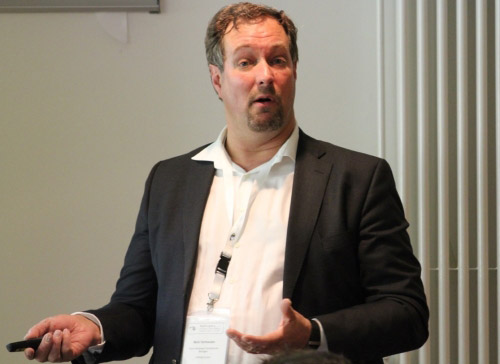







HAMBURG – European installers continue to largely avoid wireless lighting controls because they are concerned about interoperability, battery life and other issues – even though wireless offers many benefits over wired systems, an Osram boss said here.
Wireless is typically much less expensive than wired solutions such as DALI (digital addressable lighting interface) in retrofits, because it does not require costly ripping, tearing, and refinishing of office space, Osram business development manager Mark Vermeulen said at the Smart Lighting Conference 2017. Wireless also avoids the risks of accidentally drilling through electrical cables or gas conduits, as has been known to happen.
And wireless technologies offer flexibility that gives end users greater latitude in making last-minute changes to specifications such as, for example, where to place switches. While wired has advantages in security, wireless would often pose a better all-things-considered option.
“And yet, with all these benefits, there's still reluctance among installers,” Vermeulen said, noting that while wireless is gaining ground in North America, its share of installations is stuck at a flat 10% in the EMEA (Europe, Middle East, Africa) region. “So what's keeping them from accepting wireless controls?”
Vermeulen provided several of his own answers, starting with the lack of standardization.
“There are too many protocols,” he noted. “How do you make a choice?”

The dust may never truly settle on wireless lighting control standards, but the industry must strive for better interoperability, noted Osram's Mark Vermeulen. (Photo credit: Mark Halper.)
While Osram itself prefers ZigBee, there is a raft of other wireless options and movements such as Bluetooth, Thread, Wi-Fi, Z-Wave, NarrowBand, IoT, and VLC as LEDs Magazine has often noted as well as the recently announced IoT-Ready Alliance.
The preponderance of choice is itself stymying, but “even worse, there's no vendor interoperability,” Vermeulen pointed out. That, in turn, freezes installers with what he called a “fear of lock-in.” It also doesn't help that wireless technologies are not always backward-compatible with legacy systems.
Installers also worry about problematic batteries in wireless systems. Batteries can have a short or unpredictable lifetime. They can be difficult to detect and locate when they fail, and they can be troublesome to replace. Such problems erode one of the main advantages of LED lighting — that LED lamps purportedly last for a couple of decades and thereby eliminate replacement tasks.
“What installers have told me is ‘the lighting industry has solved the issue of lighting maintenance; now you give me the issue of battery maintenance,’” Vermeulen said. “It sounds very confusing to them. Because with lights, at least you can physically see when it has failed. But batteries are a headache.”
Vermeulen encouraged the lighting industry to start using batteries that last 10 years or more. He likened that idea to smoke detectors that are now available with a 10-year battery that users don't replace but rather swap out for a whole new detector after a decade.
“I think that's the direction we need to go,” he said. “You have the sensor with a built-in battery that will last as long as you need it.”
Another way around the battery problem: Embed the wireless chips inside luminaires so that the luminaire's electrical supply powers them (meaning the controls communicate wirelessly but draw their energy via physical conduit).
That's the approach that Osram is taking sometimes with its Einstone indoor-positioning system (IPS), which use Bluetooth beacons that Osram can embed in luminaires or mount outside of the luminaires.
Vermeulen said that whereas Osram prefers ZigBee for control systems, Bluetooth is more appropriate for IPS because IPS tends to communicate with smartphones, which are generally equipped with Bluetooth but not with ZigBee.
Osram's ZigBee preference for controls stems from ZigBee's stability, according to Vermeulen. He noted that ZigBee has been around for about 15 years, and it was originally developed for building management systems.
That, in turn, circles back to what is perhaps the biggest of all the challenges facing wireless: The preponderance of technologies and lack of interoperability, an area where Vermeulen said the dust may never settle.
“ZigBee has taken 15 years to actually get up to volume,” he noted. “It has taken 15 years before it became a stable standard. Now ZigBee is stable, and now we see a lot of lighting manufacturers move to Bluetooth. There will always be a cycle of technologies coming up and going down. It's a matter of having the right associations, the right cooperations, to make sure that you take the right protocol and ensure that some of these issues are solved if you want to address the issue of mass market acceptance by installers. Whether you do this with ZigBee at this moment and Bluetooth in two years’ time, that's not their concern. So the dust, I'm pretty sure, will never settle.”
Case in point: Vermeulen did not rule out an eventual move by Osram toward Bluetooth or Thread for controls.
Copyright 2006-2025 Shanghai Sinoexpo Informa Markets International Exhibition Co., Ltd. All rights reserved